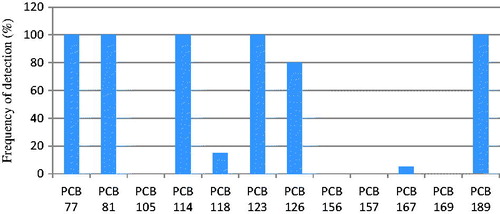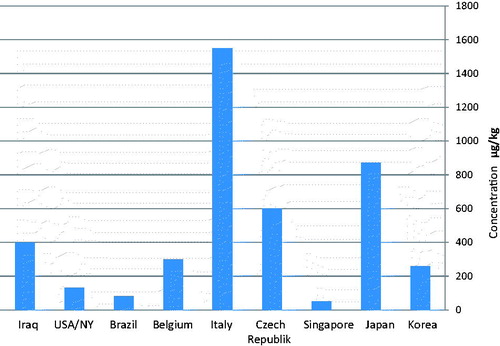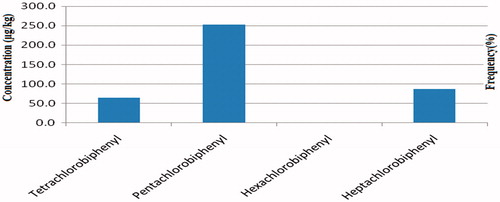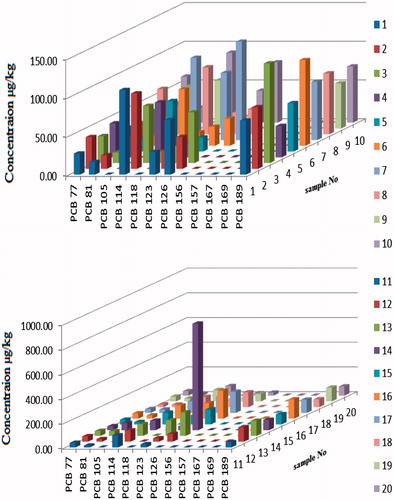Abstract
The levels of 12 polychlorinated biphenyls (PCBs) in human adipose tissue samples gathered from patients, from three different hospitals, in Bagdad/Iraq were analyzed. All samples were extracted, cleaned up, and analyzed by GC/MS for dioxin-like PCBs. The total mean concentration of PCBs in all human adipose tissues samples was 404 μg/kg. Pentachlorobiphenyls were the predominant PCB congeners, accounting for 62.56% of the total PCB concentration found in the human adipose tissue samples which represent the most toxic compounds between all dioxin-like PCB congeners. The toxicity equivalents (TEQ PCBs) in all human adipose tissue samples were found in the range of 0.0126–86.284 μg TEQ/kg. The present average TEQ of 11.52 μg/kg is within the range that obtained by other studies.
Keywords:
Introduction
PCBs become available as industrial chemicals since 1930; their widespread application in the subsequent 50 years has resulted in their presence as persistent and ubiquitous environmental contaminants and/or pollutants. Their potential carcinogenic, mutagenic, teratogenic effects, their high chemical stability and lipophilicity, and thus consequent bioaccumulation, have made their monitoring very important in environmental research (Cortazar et al., Citation2002; Gracia et al., 2001; Russo, Citation2000). PCBs are classified as carcinogenic by both the Environmental Protection Agency (EPA) and the International Agency for Research on Cancer (IARC) (Font et al., Citation1996). PCBs are considered as hazardous pollutants due to their toxicity and persistency. Toxicities and persistency are dramatically dependent on the number and positions of chlorine substituent (Robert & Diane, Citation1999). The commercial PCB mixtures were synthesized by direct chlorination of biphenyl with chlorine gas in the presence of a catalyst (Erickson, Citation1986; Furniss et al.,Citation1989). The standard reference material of PCBs is usually a solution of Aroclor mixture; each Aroclor in reality is a mixture of a several isomers. One survey found that the major use of PCBs was as dielectric in capacitors and transformers (UNEP, Citation2002). Due to their worldwide use in large quantities plus their persistency and lipophilicity, they have been identified in a wide variety of media such as air, soil, sediments, fish, birds, and humans. PCBs are widely distributed and considered hazardous to the environment due to their high toxicity and their stability in the environment (Alonso et al., Citation2001; Wolska et al., Citation2003). Their acute toxicity in animals is low (e.g. Aroclor 1254 was reported to have an oral LD50 in rats between 250 and 1300 mg/kg), while chronic exposure is very harmful (Zakrzewski, Citation1991). Out of the 209 possible PCBs congeners, only 12 show toxicity similar to PCDD/Fs. Those are which have no chlorine at the ortho-positions, the biphenyl rings can be coplanar and structurally resemble dioxin (dioxin like), which is the most toxic substance. Concentrations of organochlorines including polychlorinated biphenyls (PCBs) and organochlorine pesticides have generally been decreasing in the environment and in humans during the past few decades (Hagmar et al., Citation2006; Helgason et al., Citation2008; Lignell et al., Citation2009; Rappolder et al., Citation2007). Human specimens, such as breast milk, serum, and adipose tissues, have been used in bio-monitoring the extent of human exposure to PCBs and organohalogen contaminants (Alawi & Buthe, Citation1993; Covaci et al., Citation2008; Hardell et al., Citation2010). Measurement of contaminants in adipose tissue can provide information on steady-state concentrations and integrated levels of accumulation over time.
Many organochlorines such as p,p′-DDE and PCBs, which comprise the bulk of organochlorine residues in human adipose tissues are endocrine disrupters and carcinogens (Longnecker et al., Citation1997). Other studies show that prenatal exposure to endocrine disrupters lead to increased body weight as well as several metabolic disorders, which may contribute to the obesity (Barouki et al., Citation2015).
After the American invasion in Iraq in 2003, it was necessary to find out the degree of environmental pollution caused by this war.
In the present study,12 PCB congeners were quantified in adult adipose tissue samples (n = 20) gathered from Baghdad/Iraq using gas chromatography with mass spectrometric detector and then the potential influence of sex, age, body weight, smoking habits, and type of food consumption on the concentration of PCBs were investigated, calculating the toxicity equivalents (TEQ) of PCBs, comparing the results with the allowable concentrations of the World Health Organization (WHO) and comparing our results with those from other countries.
Materials and methods
Sampling and sample locations
Twenty adipose tissue samples combined with questionnaires () about many factors (sex, age, body weight, smoking habit, and food type) were gathered from patients in cooperation with competent physicians from three different hospitals (Al-Kadhimiya, Al-Yarmouk, and Al-Kindy hospital) in Baghdad/Iraq.
Table 1. Participants' data.
Samples were collected from the previously mentioned hospitals with the help of surgeons in these hospitals and all adipose specimens were taken from patients performing surgery in the above-mentioned hospitals. Adipose tissue samples taken from the abdominal fat layers were obtained from the patients, specifically for this study, after getting their agreement between January and February 2014. All samples were stored at −20 °C until analysis. The age of the donors was ranged from 15 to 60 years (average 32.4 years).
Chemicals and reagents
PCBs: standard mixture of (10 mg/L in hexane) containing 12 of the PCBs priority pollutants were purchased from Dr. Ehrenstorfer (Augsburg, Germany). These 12 PCB congeners were: 3,3′,4,4′-tetrachlorobiphenyl (PCB-77); 3,4,4′,5-tetrachlorobiphenyl (PCB-81); 2,3,3′,4,4′-pentachlorobiphenyl (PCB-105); 2,3,4,4′,5-pentachlorobiphenyl (PCB-114); 2,3′,4,4′,5-pentachlorobiphenyl (PCB-118); 2′,3,4,4′,5-pentachlorobiphenyl (PCB-123); 3,3′,4,4′,5-pentachlorobiphenyl (PCB-126); 2,3,3′,4,4′,5-hexachlorobiphenyl (PCB-156); 2,3,3′,4,4′,5′-hexachlorobiphenyl (PCB-157); 2,3′,4,4′,5,5′-hexachlorobiphenyl (PCB-167); 3,3′,4,4′,5,5′-hexachlorobiphenyl (PCB-169); 2,3,3′,4,4′,5,5′-heptachlorobiphenyl (PCB-189). The internal standard Isodrin was purchased from Dr. Ehrenstorfer (Augsburg, Germany). The chemicals used for extraction were purchased as follows: Florisil 60–100 mesh (Riedel-de Haën, Hannover, Germany), anhydrous sodium sulfate, extra pure for analysis (Sheung, Korea), silica gel MN Kieselgel, 60 M (230–400 mesh) ASTM Saulen-Chromatography (Dueren, Germany), sulfuric acid 96% PA-ISO Panreac (Barcelona, Spain), dichloromethane, HPLC grade was purchased from Janssen Chimica (Beersel, Belgium), n-Hexane (ACS grade >95%) was purchased from TEDIA (Fairfield, OH) and petroleum ether (ACS grade >95%) was purchased from Carlo Erba (Milan, Italy).
Sample extraction and clean-up
One gram of each homogenized adipose tissue samples was extracted in a Soxhlet apparatus, for 8 h (about 15 min for each cycle) using 150 mL petroleum ether. The solvent was then evaporated using the rotary evaporated at 40 °C and 100 mbar to ca. 3 mL (Alawi & Ababneh, Citation1991, with slight modification).
A first column (30 × 1.6 cm) was prepared as follows: 2 g of anhydrous sodium sulfate, 10 g of sulfuric acid-impregnated silica gel (40% w/w), and 2 g of anhydrous sodium sulfate. A second column (30 × 1.6 cm) was prepared as follows 25 g of Florisil (3% w/w, deionized water) (60–100 mesh) were filled into the column, then 1 cm of anhydrous sodium sulfate was added. The first column was washed with 100 mL petroleum ether, and then the residues from the extraction step were added to this column and eluted with 100 mL dichloromethane. The eluats were added to the second column and eluted with 60 mL dichloromethane and 240 mL of petroleum ether, the eluates were concentrated at 40 °C and 100 mbar to ca. 1 mL, then to dryness using a gentle stream of nitrogen. The residues were dissolved in 1.0 mL n-hexane containing 1 μg/mL internal standard (Isodrin), and then 2 μL were injected onto the GC/MS column (Alawi & Heidmann, Citation1991, with slight modification).
Analysis
Gas chromatograph (Agilent 6890 series II gas chromatograph with Auto-sampler injector series 7683) was used for PCBs analysis. Injected volume: 1 μL/splitless, Column: BPX-5 (30 cm × 0.25 mm i.d. × 0.25 μm film thickness). Carrier gas: He (99.999%, 8 psi). Temperature program: 100 °C (10 min), 100–160 °C (25 °C/min), 160–270 °C (5 °C/min) and 270 °C (27 min). Detector: mass selective quadrupole – detector, Agilent 5973 N (MSD), Auxiliary (transfer line): 280 °C, Electron Impact Ionization, Ionization Energy: 70 eV. Calibration substance: Perflourotributylamine (PFTBA), Tuning masses: 69/219/502 m/z.
Acquistion mode: Selective ion monitoring (SIM) – mode and scan mode. Data analysis: HP MSD productivity Chemstation software.
Method validation
Linear range
For the calculation of the performance data, a calibration was carried out with three concentration levels for PCBs 100, 500, and1000 μg/L. From the resulting calibration curves, the regression coefficients were calculated, characterizing the linearity of the calibration function. The regression coefficients were between 0.991 and 0.999, indicating a good linearity of the calibration function in these concentration ranges.
Detection limits and limits of quantitation
The limits of detection (LOD) and lower limits of quantitation (LLOQ) were calculated as S/N ratio is equal 3 and 10, respectively. shows LOD and LLOQ values for PCBs.
Table 2. Peak number in the chromatogram, retention time (tR), limits of detection (LOD), and lower limits of quantitation (LOQ) for instrument PCBs standard mixture.
Instrument precision of PCBs
The precision of the instrument was measured through the injection of standard solutions (100, 500, 1000 μg/L), each three times. The coefficients of variation (CV) were found to be less than the accepted limit value for trace analysis (CV <15%) (Gonzalez et al., Citation2010); these results show that we have a good instrument precision.
Recoveries
Two samples, each 1 g of sheep adipose tissue blank sample, were spiked with the PCBs standard mixture to give the concentrations of 100 and 1000 μg/kg. These samples were mixed thoroughly and extracted, cleaned up and analyzed according to the above mentioned method. The recovery tests were done in triplicate at different times, and then average recoveries were calculated. The average recoveries of PCBs (100 μg/kg) were found between 84–109% and for 1000 μg/kg were found between 80–107%. All recoveries were found to lie within the acceptable range for trace analysis of 80–120% (Gonzalez et al., Citation2010).
Results and discussions
Each of the 20 collected adipose tissue samples was extracted and cleaned up twice as mentioned in the Section “Sample extraction and clean-up” and each extract was injected twice onto the GC/MS column. The net result was calculated as the average for the 4 values by calculating relative peak area (RPA) for each compound in the unknown chromatogram and calculating RPA of the same compound in the standard mixture chromatogram then making a comparison between RPA for standard and RPA for unknown with concentration.
In this study, some of the dioxin-like PCBs have been determined in human adipose tissue samples collected from different regions of Baghdad/Iraq. The mean age of the monitored population was 32.4 years (range 15–60). Divided according to sex, the mean age for females was 26.6 years (range 15–60), and for males it was 41 years (range 19–60).
Comparing the concentration of the studied 12 compounds we have noticed that PCB-77 was found in the concentration range between 21.72 μg/kg (sample 18) and 59.54 μg/kg (Sample 10). PCB-81 was found in the concentration range between 12.40 μg/kg (Sample 6) and 57.53 μg/kg (Sample 14). PCB-114 was found in the concentration range between 62.1 μg/kg (Sample 9) and 109.33 μg/kg (Sample 1). PCB-118 was found just in three Samples 3, 4 and 6, at the concentrations 14.86, 15.39, and 17.58 μg/kg, respectively. PCB-123 was found in the concentration range between 16.28 μg/kg (Sample 9) and 130.63 μg/kg (Sample 17). PCB-126 was found in the concentration range between 0.00 μg/kg (Samples 4, 5, 9, and 11) and 862.57 μg/kg (Sample 14). PCB-189 was found in the concentration range between 40.51 (Sample 4) and 156.52 μg/kg (Sample 16).
PCB-156, -157, -167, -169 were not found in all human adipose tissue samples. All previous results are presented in and .
Table 3. The TEF values of dioxin-like PCBsTable Footnotea and the average concentrations of the Samples 1–20 (μg TEQ/kg fresh weight).
shows the frequencies of detection of the studied 12 PCB congeners (dioxin-like PCBs) in human adipose tissues samples. Five congeners (PCB-77, -81, -114, -123, and -189) were found in the studied samples with a 100% frequency, followed by PCB-126 with a 80% frequency, PCB-118 and PCB-167 which were found in low frequencies of 15 and 5%, respectively.
Figure 2. Frequency percentage of individual congeners of PCBs detected in all 20 human adipose tissue samples.

The overall mean concentrations of PCBs in the Iraqi human adipose tissue samples were within the range of other results reported for different countries (USA/NY, Brazil, Belgium, Singapore, Korea, Japan, Italy and the Czech Republic) (Cok et al., Citation2010; Johnson-Restrepo et al., Citation2005; Kunisue et al., Citation2007; Moon et al., Citation2012; Pulkrabova et al., Citation2009; Schiavone et al., Citation2010; Tan et al., Citation2008; Waliszewski et al., Citation2010). In Italy, the total concentrations of PCBs were very high because of manufacturing these compounds till now, for example in Caffaro Company. The total concentration of PCBs in human adipose tissue samples from the above-mentioned countries and in Iraq (this study) are shown in .
Figure 3. Comparison of total concentration of PCBs in human adipose tissues from different countries.

The total concentration of PCBs in Iraq is less than those found in Italy, the Czech Republic and Japan, but more than those found in Korea, Singapore, Belgium, Brazil, and USA/NY.
Pentachlorobiphenyls are the predominant PCB congeners, accounting for 62.56% of the total PCB concentration found in Iraqi human adipose tissue samples which represent the most toxic compounds between all congeners of dioxin-like PCBs, followed by heptachlorobiphenyls (21.5%) and tetrachlorobiphenyls (15.77%). Hexachlorobiphenyls were found with the lowest accounting frequency of 0.12% of total PCB concentration as shown in . This is the first research dealing with the congener-specific concentrations of PCBs in Iraqi human adipose tissues and establishes a base line data for future studies in Iraq.
Figure 4. Average concentrations (μg/kg) of PCB congeners in human adipose tissue samples with the percentage frequency.

For a single dioxin-like compound (DLC), the dioxin toxicity equivalence (TCDD TEQ) is the product of the concentration of the DLC in an environmental mixture and its corresponding toxic equivalency factor (TEF); total TEQ for the mixture is the sum of the individual TCDD TEQs across the DLCs present in the mixture:
Where Ci is the individual DLC concentration in the environmental media and TEFi is the toxicity equivalence factor assigned for the DLC.
The dioxin-like PCBs, including four non-ortho (PCB-77, PCB-81, PCB-126, and PCB-169) and eight mono-ortho (PCB-105, PCB-114, PCB-118, PCB-123, PCB-156, PCB-157, PCB-167, and PCB-189) substituted congeners that have shown in experimental systems to exert a number of responses similar to those observed for 2,3,7,8-TCDD (Poon et al., Citation2005). There is an evidence to suggest that there is a common mechanism of action of TCDD and these dioxin-like PCBs in biological systems, based on their binding to an intercellular protein, the Ah-receptor (Safe, Citation1992). shows an estimation of toxic equivalency concentration (TEQ) of dioxin-like PCBs found in present study. The calculation is based on the study of van den Berg et al. (Citation1997). The toxic equivalents (TEQ PCBs) in all human adipose tissue samples were found in the range of 0.00126–86.284 μg TEQ/kg for Samples 5 and 14 respectively. The present average TEQ of 11.49 μg/kg is much higher than those obtained from Hong Kong human adipose tissues (0.00211 μg/kg) (Poon et al., Citation2005) and higher than those found for Japanese human adipose tissues (0.0153 μg/kg) (UNEP, Citation2002).
There was no correlation found for the calculated total TEQ of the samples with the data collected from the donors in (sex, age, body weight, smoking habit and food type).
Conclusion
The results of this study show that the highest TEQ value of dioxin-like PCBs was found in Sample 14 [∑ (μg TEQ/kg) = 86.284] because the person from whom this sample was taken, lives in the New Baghdad region area which is located next to the area of military camps and agricultural land. The smallest TEQ values of dioxin-like PCBs was found in Sample 5 [∑ (μg TEQ/kg) = 0.0126], the person from whom this sample was taken lives in the area Al-Sha'ab District where there is no military camps in this region. We found that there is a relationship between the concentration of PCBs and the place where the donor lives, but there was no correlation found with all other data collected from the donors.
Acknowledgements
The authors would like to thank the Deanship for Academic Research at the University of Jordan for the financial support. Informed consent was obtained from all individual participants included in the study. The protocol of this research project has been approved by a constituted Ethics Committee of the institutions within which the samples were collected.
Declaration of interest
The authors report no declaration of interest regarding the publication of this manuscript.
References
- Alawi MA, Ababneh M. (1991). Residue analysis of chlorinated pesticides in Jordanian human adipose tissues. Anal Lett 24:1897–911.
- Alawi MA, Heidmann WA. (1991). Analysis of polychlorinated biphenyls (PCB) in environmental samples from the Jordan valley. Chemosphere 33:93–9.
- Alawi MA, Buthe A. (1993). Identification of PCB-individual congeners in Jordanian mother milk by GC-MS. Fres Environ Bull 2:206–13.
- Alonso GS, Pérez-Pastor RM, Quejido-Cabezas AJ. (2001). Optimized chromatographic method for the measurement of selected polychlorinated biphenyls in ambient air. Anal Chim Acta 440:223–30.
- Barouki R, Antiganc JP, Emond C, et al. (2015). Kim d Obesity, ebook ecog-obesity. Available at: eu/chapter-biology/adipose-tissue-pollutants-obesity.
- Cok I, Durmaz TC, Durmaz E, et al. (2010). Determination of organochlorine pesticide and polychlorinated biphenyl levels in adipose tissue of infertile men. Environ Monit Assess 162:301–9.
- Cortazar E, Zuloaga O, Sanz J, et al. (2002). MultiSimplex optimization of the solid-phase microextraction–gas chromatographic–mass spectrometric determination of polycyclic aromatic hydrocarbons, polychlorinated biphenyls and phthalates from water samples. Chromatogr A 978:165–75.
- Covaci A, Voorspoels S, Roosens L, et al. (2008). Polybrominated diphenyl ethers (PBDEs) and polychlorinated biphenyls (PCBs) in human liver and adipose tissue samples from Belgium. Chemosphere 73:170–5.
- Erickson MD. (1986). Analytical chemistry of PCBs. 2nd ed. Boston (MA): CRC Press.
- Font G, Mañes J, Moltó JC, Picó Y. (1996). Current developments in the analysis of water pollution by polychlorinated biphenyls. Chromatogr A 733:449–71.
- Furniss BS, Harmaford AJ, Smith PWG, Tatchell AR. (1989) VOGEL's – textbook of practical organic chemistry. 5th ed. New York: John Wiley & Son Inc. 835–7 and 860.
- Gonzalez A, Ángeles Herrador M, Agustín GA. (2010). Intra-laboratory assessment of method accuracy (trueness and precision) by using validation standards. Talanta 82:1995–8.
- Hagmar L, Wallin E, Vessby B, et al. (2006). Intra-individual variations and time trends 1991–2001 in human serum levels of PCB, DDE and hexachlorobenzene. Chemosphere 64:1507–13.
- Hardell E, Carlberg M, Nordstrom M, van Bavel B. (2010). Time trends of persistent organic pollutants in Sweden during 1993–2007 and relation to age, gender, body mass index, breast-feeding and parity. Sci Total Environ 408:4412–9.
- Helgason LB, Barrett R, Lie E, et al. (2008). Levels and temporal trends (1983-2003) of persistent organic pollutants (POPs) and mercury (Hg) in seabird eggs from Northern Norway. Environ Pollut 155:190–8.
- Johnson-Restrepo B, Kannan K, Rapaport DP, Rodan BD. (2005). Polybrominated diphenyl ethers and polychlorinated biphenyls in human adipose tissue from New York. Environ Sci Technol 39:5177–82.
- Kunisue T, Takayanagi N, Isobe T, et al. (2007). Polybrominated diphenyl ether and persistent organochlorines in Japanese human adipose tissue. Environ Int 33:1048–56.
- Lignell S, Aune M, Darnerud PO, et al. (2009). Persistent organochlorine and organobromine compounds in mother's milk from Sweden 1996-2006: compound-specific temporal trends. Environ Res 109:760–7.
- Longnecker MP, Rogan WJ, Lucier G. (1997). The human health effects of DDT (dichlorodiphenyltrichloroethane) and PCBS (polychlorinated biphenyls) and an overview of organochlorines in public health. Annu Rev Public Health 18:211–44.
- Moon HB, Duk-Hee L, Yoon SL, et al. (2012) Polybrominated diphenyl ethers, polychlorinated biphenyls, and organochlorine pesticides in adipose tissues of Korean women. Arch Environ Contam Toxicol 62:176–84.
- Poon BHT, Leung CKM, Wong CKC, Wong MH. (2005). Polychlorinated biphenyls and organochlorine pesticides in human adipose tissue and breast milk collected in Hong Kong. Arch Environ Contam Toxicol 49:274–82.
- Pulkrabova J, Hradkova P, Hajŝlova J, et al. (2009). Brominated flame retardants and other organochlorine pollutants in human adipose tissue samples from the Czech Republic. Environ Int 35:63–8.
- Rappolder M, Schroter-Kermani C, Schadel S, et al. (2007). Temporal trends and spatial distribution of PCDD, PCDF, and PCB in pine and spruce shoots. Chemosphere 67:1887–96.
- Robert AM, Diane KD. (1999). Encyclopedia of environmental pollution and clean up. 2nd ed. 1329–38.
- Russo MV. (2000). Diol Sep-Pak cartridges for enrichment of polychlorinated biphenyls and chlorinated pesticides from water samples, determination by GC-ECD. Chromatographia 52:93–8.
- Safe S. (1992). PCBs, PCDD/F and related compound: environmental and mechanistic considerations which support the development of toxic equivalency factors. CRC Crit Rev Toxicol 21:51–88.
- Schiavone A, Kannan K, Horii Y, et al. (2010). Polybrominated diphenyl ethers, polychlorinated naphthalenes and polycyclic aromatic musks in human fat from Italy: comparison to polychlorinated biphenyls and organochlorine pesticides. Environ Pollunt 158:599–606.
- Tan J, Li QQ, Laganath A, et al. (2008). Multivariate data analyses of persistent organic pollutants in maternal adipose tissue in Singapore. Environ Sci Technol 42:2681–7.
- United Nations Environmental Programme, PCB Transformers and Capacitors, from Management to Reclassification and Disposal, First Issue May 2002.
- Waliszewski SM, Valencia Quintana R, Corona CA, et al. (2010). Comparison of organochlorine pesticide levels in human adipose tissue, of inhabitants from Veracruz and Puebla, Mexico. Arch Environ Contam Toxicol 58:230–6.
- Wolska L, Galer K, Namiesnik J. (2003). Transport and speciation of PAHs and PCBs in a river ecosystem. Polish J Environ Stud 12:105–10.
- van den Berg M, Birnbaum L, Bosveld ATC, et al. (1997). Toxic equivalency factors (TEFs) for PCBs, PCDDs, PCDFs for humans and wildlife. Environ Health Perspect 106:775–92.
- van den Berg M, Birnbaum LS, Denison M, et al. (2006). The 2005 World Health Organization reevaluation of human and Mammalian toxic equivalency factors for dioxins and dioxin-like compounds. Toxicol Sci 93:223–41.
- Zakrzewski SF. (1991). Principles of environmental toxicology. Washington (DC): American Chemical Society, 270.


